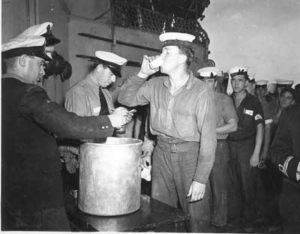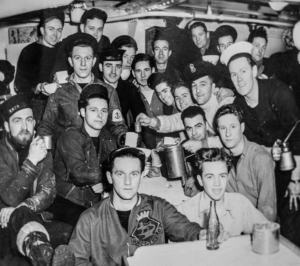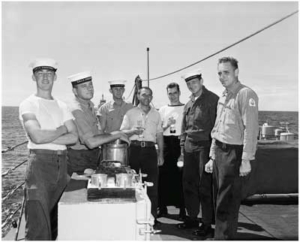The history of spirits and navies goes back centuries.
When the Canadian Naval Service was established in 1910, it inherited a rich history of naval customs from Britain’s Royal Navy. Like other Dominion navies of the time, Canada followed Kings Regulations and Admiralty Instructions for naval routines and practices, which included the daily issuing of spirits in His/Her Majesty’s Ships. [1] Over the years these procedures were incorporated into subsequent Canadian regulations, and this practice remained unchanged in Canada’s navy for over 60 years, including surviving the unification of the Armed Forces in 1968.
The daily spirit issue of rum to those serving in HMC Ships continued until 30 March 1972, when it was considered to be at odds with the operation of modern sophisticated warships and Canadian societal norms. While Canada was not the first Commonwealth nation to cease the practice of the daily rum issue (the Royal Navy ceased this practice in 1970), neither was it the last, as that honour fell to the Royal New Zealand Navy on 1 March 1990.
What was the history behind the issue of alcoholic beverages onboard warships? As with most customs and traditions, there are good underlying reasons for these practices, but it’s important to look at the facts from a contemporary perspective that may not be intuitively obvious in the 21st century. The issue to sailors of beer, wine and spirits in lieu of tea, cocoa and water originated during the ‘age of fighting sail’, when the water aboard ship was often undrinkable during long sea voyages. Moreover, while a good quality beer was seen as a defence against scurvy, the quality of beer supplied to the Royal Navy was considered to be poor. Increasingly, sailors were issued wine mixed with water and later brandy, then whisky, and subsequently rum. Beer was supplied when the ship was in port or for the first few days at sea until 1831, when rum became the only beverage, as it kept well at sea over long periods. Coincidentally, Britain’s extensive colonial interests in the Caribbean ensured a steady and inexpensive supply.

Enjoying a ‘tot’ aboard HMCS PRINCE ROBERT, 1945. Photo #VRP1993.399.176 from the museum collection.
The routine issue of spirits changed with the times, and it was often modified to reflect shifting societal norms. In the beginning, spirits were issued twice a day, later watered down at a ratio of 4:1 to form ‘grog’ [2], then further reduced in quantity and to a single issue per day. By the mid-19th century, the daily rum issue became a standardized practice that Canada would eventually adopt in 1910. It was a practice that reflected the norms of Britain’s class-oriented society; rum was considered to be a sailor’s drink, and by 1881, officers were no longer entitled to a daily issue. That restriction was further extended to Warrant Officers in 1918.
In the RCN (and later the CAF), policies with regards to alcoholic drink continued to follow traditional Royal Navy practice. Officers had access to beer, wines and spirits without restriction, Senior Rates could have beer without restriction, and Junior Rates (Leading Seaman and below) had beer through ‘wet canteens’. With regards to the daily issue of rum at public expense, officers were not entitled, and Chiefs and Petty Officers had the privilege of taking their ration neat and enjoying it at their leisure in their messdeck. Junior sailors, however, ‘drew their tot’ under the watchful eye of the Coxswain and the Issuing Officer – usually the Supply Officer at sea or Officer-of-the Day in harbour – and had to mix their rum with two parts of either water or cola to one part rum. They then had to consume their tot immediately in front of both the Issuing Officer and the Coxswain.
Thus the issue of a ‘tot’ (a measure equivalent to 2-1/2 US ounces of rum), to sailors above the age of 20 (deemed legal age), as part of the daily routine of “Up Spirits”, remained fundamentally unchanged until 1972. It’s worth noting that not all ratings chose to draw their tot. They could instead choose to take cash payment in lieu, which in 1945 was the princely sum of five cents per day. For the RCN, the rum that was issued was an overproof variety blended and bottled expressly for the Royal Canadian Navy by Captain Morgan of Waterloo Ontario, which traditionally used rums from Barbados, Guyana, Jamaica and Trinidad.
In 1972, in keeping with Canadian Armed Forces Messes and Institutes policies, the daily spirit issue was abolished and beer, wines and spirits were now sold in all three ship’s messes – the Wardroom (Officer’s mess), the Chiefs and Petty Officers Mess and the Master Seaman and Below Mess. Moreover, at that time, the serving of spirits at sea was discontinued in favour of a policy of beer and wine only at sea and spirits whilst alongside.
In 2014, as a result of a review of fleet practices stemming from reported alcohol-related incidents onboard HMC Ships, the consumption of any form of alcohol at sea was discontinued as a normal practice – special permission is now required. Of note, in exceptional circumstances, the ability of a Commanding Officer to order an issue of spirits to the ship’s company remains.
Throughout the history of the Canadian navy, alcohol consumption has always been closely monitored, particularly at sea. The ship’s Commanding Officer examines the entire ship’s consumption logs from each mess as a part of a number of weekly and monthly reviews of the books, and has the ability to restrict consumption levels should they appear excessive. Moreover, for officers, if the Commanding Officer has cause for concern he/she can call for review of a particular officer’s mess bill at any time. A Commanding Officer can order a stoppage of alcoholic drink should he/she consider there to be a problem with that officer, be it job performance, excessive drinking or accumulating debt through large unpaid mess bills.
These practices continue to this day, showing how the Navy continues to modify its policies to reflect the expectations of an ever-evolving Canadian society.
Footnotes:
- This policy included RCN shore establishments, which were designated as HMC Ships (e.g. HMCS Naden now CFB Esquimalt).
- On 21 August 1740, Vice-Admiral Vernon (Commander-in-Chief West Indies) issued an order that a quart of water was to be mixed with the half-pint of rum. This mixture became known as “grog” in reference to a cloak made of grogam cloth that the Admiral wore while on deck..
Bibliography
Arbuckle, Graeme, Customs and Traditions of the Canadian Navy, Halifax: Nimbus, 1984.
Lowry, R.G.The Origins of Some Naval Terms and Customs, London: Sampson Low, Marston & Co. Ltd, n.date.


 CFB Esquimalt Naval and Military Museum
CFB Esquimalt Naval and Military Museum CFB Esquimalt Naval and Military Museum
CFB Esquimalt Naval and Military Museum CFB Esquimalt Naval and Military Museum
CFB Esquimalt Naval and Military Museum CFB Esquimalt Naval and Military Museum
CFB Esquimalt Naval and Military Museum CFB Esquimalt Naval and Military Museum
CFB Esquimalt Naval and Military Museum CFB Esquimalt Naval and Military Museum
CFB Esquimalt Naval and Military Museum CFB Esquimalt Naval and Military Museum
CFB Esquimalt Naval and Military Museum CFB Esquimalt Naval and Military Museum
CFB Esquimalt Naval and Military Museum CFB Esquimalt Naval and Military Museum
CFB Esquimalt Naval and Military Museum CFB Esquimalt Naval and Military Museum
CFB Esquimalt Naval and Military Museum CFB Esquimalt Naval and Military Museum
CFB Esquimalt Naval and Military Museum CFB Esquimalt Naval and Military Museum
CFB Esquimalt Naval and Military Museum CFB Esquimalt Naval and Military Museum
CFB Esquimalt Naval and Military Museum CFB Esquimalt Naval and Military Museum
CFB Esquimalt Naval and Military Museum CFB Esquimalt Naval and Military Museum
CFB Esquimalt Naval and Military Museum CFB Esquimalt Naval and Military Museum
CFB Esquimalt Naval and Military Museum CFB Esquimalt Naval and Military Museum
CFB Esquimalt Naval and Military Museum